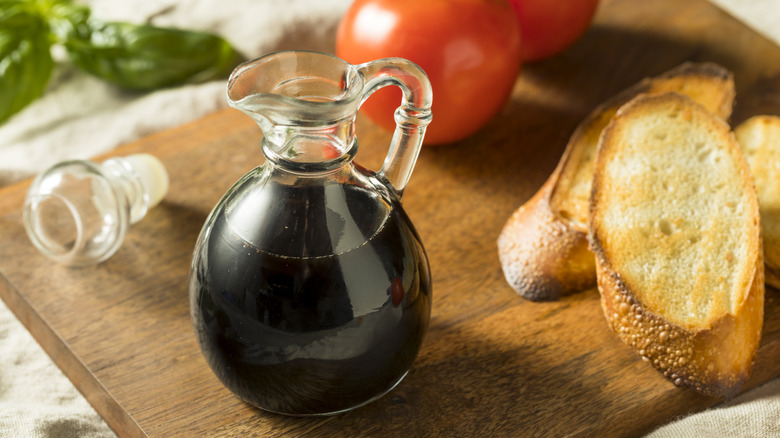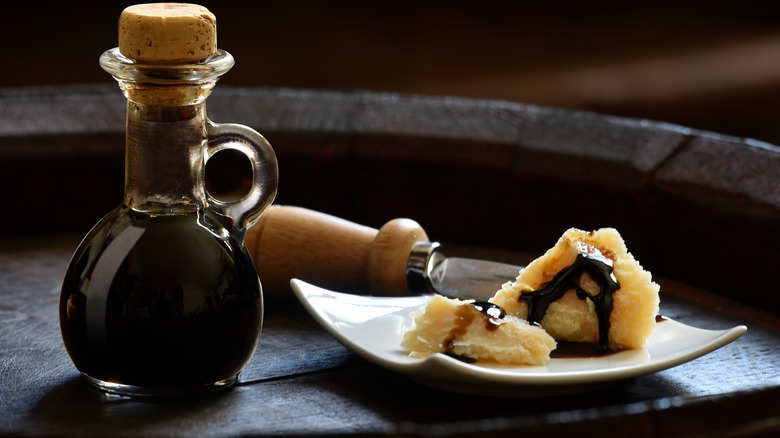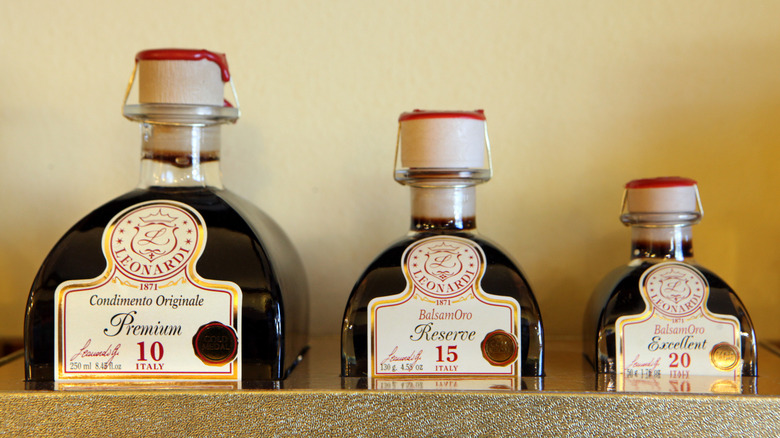You've Probably Never Tasted Real Balsamic Vinegar
When you think of balsamic vinegar, you may call to mind its sweet yet tart flavor, viscous texture, and glossy black appearance. Perhaps you've enjoyed it drizzled on a fig and goat cheese crostini or on a traditional antipasti salad. Either way, balsamic vinegar is a culinary icon, and while many may say they have enjoyed real balsamic vinegar before, the truth is, most have never tasted the real stuff.
This may seem like an audacious claim considering how ubiquitous this ingredient is, but, the simple fact is that traditional balsamic vinegar is incredibly difficult, not to mention costly, to make, requiring decades to age into its nuanced flavor. The ingredients and equipment must be top-notch, and their authentic provenance is closely monitored by the European Union's D.O.P. (Denominazione di Origine Protetta). In the end, genuine balsamic vinegar is so rare and expensive, chances are you've never actually tasted it before, with the bottle in your pantry being a mere imitation that uses flavor additives and coloring.
So, what exactly does it take to make this valuable and flavorful vinegar? And what does the "real stuff" taste like?
The arduous process of making balsamic vinegar
Balsamic vinegar's journey begins in either the Modena or Reggio Emilia provinces in Italy, both offering the perfect agricultural backdrop for production as the climate is cold enough for aging the vinegar and the grapes produced in the region (the sweet white grape Trebbiano being the one most commonly used) having the right chemical makeup.
Authentic balsamic vinegar is made of only one ingredient, mosto aka "grape must," a sweet juice extracted from freshly pressed sweet white grape varieties and boiled until its volume has been significantly reduced. Still, this ingredient isn't only what makes balsamic vinegar so signature; the secret to the syrup lies in its lengthy aging process.
At the very least, the vinegar must be aged 12 years, but like fine wine or bourbon, its quality and price rise the longer it processes. During aging/fermentation, the vinegar will concentrate even further, losing about 10% moisture every year. The barrels it's kept in are made of high-quality, aromatic wood, like oak, juniper, ash, and mulberry, with the vinegar expected to take on a bit of those flavors. At the beginning of the aging process, these barrels are large, but as time goes on, the vinegar is transferred to smaller and smaller casks. The resulting flavor is undeniably sophisticated and savored by the drop. Once bottled, this traditional balsamic vinegar can be priced from anywhere between $50 to $200 for a mere three ounces.
How to spot genuine balsamic vinegar
If you're willing to invest in a quality balsamic vinegar, there are a few things to keep an eye out for when shopping. First, many Italian balsamic vinegars (often marked as condimento) may be marked with I.G.P. (protected geographical indication), which means that the grapes are sourced from the authentic Modena and Reggio Emilia areas. Everything else, from the tedious aging process to the barrels used, is not monitored by this distinction, so check for the D.O.P. mark if that's important to you. Second, look at the ingredient list; if there's anything other than grape must listed, it's not the real thing.
So, what about the bottle of balsamic vinegar you currently have sitting in your pantry? This imitation vinegar, often called balsamic vinegar of Modena rather than the authentic Aceto Balsamico Tradizionale di Modena, is mass-produced using a shortcut, opting for wine vinegar rather than grape must. Seldom aged and often stored in steel vats rather than wooden barrels, it has more of a one-note aroma. The lowest quality of this kind of vinegar will contain suspect ingredients like caramel, coloring, or thickening agents. On the upside, you can get it for as cheap as $5 depending on where you shop.



